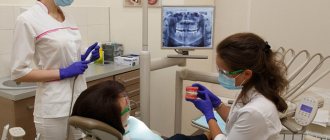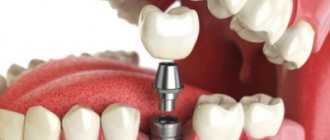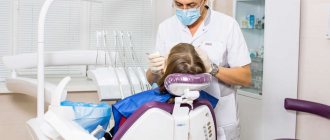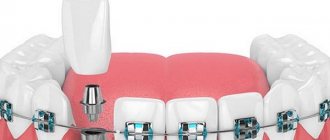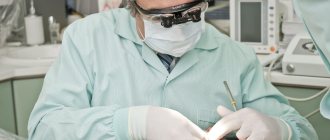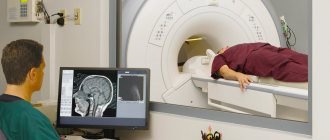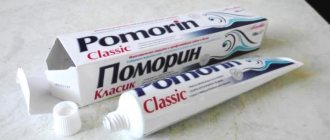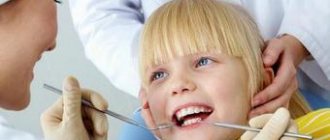Table: how to figure out who to contact
| What's troubling? | Which dentist should I contact? |
| Bleeding gums/Teeth sensitivity | Hygienist or periodontist |
| Missing teeth | Orthopedist |
| Have crooked teeth/bad bite | Orthodontist |
| Tooth hurts / The wall has broken off / There is caries | Therapist |
| The wisdom tooth is painfully erupting / Swelling has appeared on the side of the cheek | Surgeon |
All dentists conduct an examination, consultation, draw up a treatment plan and perform a thorough diagnosis of the entire oral cavity. In modern dentistry, an integrated approach to each clinical situation is valued, taking into account all the individual characteristics of the patient’s body.
Dentist-therapist
The main field of activity of this doctor: treatment and prevention of caries and its complications. What manipulations does:
- treatment of caries;
- endodontics (work in root canals) for pulpitis, periodontitis;
- root canal retreatment;
- chipped fillings, tooth walls;
- carrying out treatment using a microscope (treatment of caries, work in canals);
- providing assistance for acute toothache.
The therapist also conducts a thorough examination and can refer the patient to related specialists if he notices any pathology.
Maxillofacial surgeon
This specialist is needed for those whose bite pathology requires surgery. Usually this is a pronounced mesial bite or a combination of several disorders, especially with a pathological narrowing of the jaw. The operation itself is only one of the stages of treatment; in preparation for it and after it, you still need to wear braces to stabilize the occlusion (closing of the teeth) and improve the aesthetics of the smile.
Surgical correction of the bite: the jaws are given the correct shape, but the teeth still need alignment
Dental hygienist
A dental hygienist has a secondary professional medical education. A prerequisite for working as a hygienist is to successfully complete the course “Preventive Dentistry”. What does a dental hygienist do:
- professional oral hygiene;
- treatment of gums with the Vector device;
- whitening;
- provides training in proper oral hygiene;
- selection of personal hygiene products;
- deals with the prevention of gum disease in adults and children.
In short, the main area of work of a dental hygienist is the removal of dental plaque (tartar, plaque). It is important to see a hygienist every six months to maintain oral health.
Orthopedic dentist
Dental services include dental prosthetics. It is the orthopedic dentist who deals with all types of dental restoration using orthopedic structures. These include:
- crowns;
- bridges;
- veneers, lumineers;
- inlays, overlays;
- mouthguards, splints;
- temporary structures for long-term orthopedic treatment;
- removable and fixed dentures;
- prosthetics on implants.
What treatment methods does the orthodontist use?
There are various methods of orthodontic treatment. The most common of these is hardware3. It involves the use of various designs - removable and non-removable3,11 - with which you can9:
- expand or narrow the dentition;
- speed up or slow down the rate of jawbone growth;
- change the position of individual teeth and the position of the lower jaw.
The devices that the orthodontist works with include:
- Braces are a non-removable system that is fixed on the teeth3,9. It includes the braces themselves, rings, locks and arches3. These elements put pressure on the teeth, moving them in the desired direction3. The method is considered one of the most effective, which is why braces are used to correct most malocclusions4.
- Plates are removable devices with various active elements (screws, springs, hinges). They permanently or intermittently attack the teeth and jawbone3. Plates can be placed at any age, but the best age is considered to be 6-9 years11.
- A pre-orthodontic trainer is a removable elastic aligner that is usually placed at night3. It improves the position of teeth and normalizes breathing, swallowing and muscle tone1.
- Aligners are transparent aligners made of a special thermoplastic material5. They are made after computer 3D modeling of human jaws5, which allows you to see the final result even before they are installed. Aligners should be worn 24 hours a day, removed when eating and brushing teeth, and replaced with new ones every 2 weeks7.
Pediatric dentist
Treatment and extraction of teeth for patients under 18 years of age is carried out by a pediatric dentist. When working with young patients, the primary task is to find contact with the child and get him ready for treatment, because almost all children enter any medical office with fear. In addition, the children's doctor needs to tell the child's parents how to carry out home oral hygiene for the baby, what products to use, when the physiological change of teeth occurs, etc.
Maintaining dental health from a very early age is necessary for the normal formation of the dental system.
Is it difficult to become one?
The work of an orthodontist is very painstaking and hard work, which most often pays quite well. To obtain this qualification, you also need to work hard.
To do this, you need to go through several steps:
- Studying at a medical university at the Faculty of Dentistry.
- Completion of residency or internship in the specialty “orthodontics”.
- Receiving additional training in dental courses.
On average, the main period of study lasts about 8 years.
Gnathologist
Not everyone has heard of this doctor, and this is no accident. This profession is very rare.
This specialist deals with pathologies of the temporomandibular joint. If the patient is bothered by clicking in the joint, pain when opening the mouth, tooth wear, discomfort in the joint when chewing, then it is necessary to contact a gnathologist to eliminate the pathology.
- Pavel
October 7, 2022 at 08:17Thank you for your article, I learned a lot of new things. I had never had any problems with my teeth in my life, so there was no need to understand the areas of dentistry. And now the situation has changed, the first signs of dental ill health have appeared, we have to figure it out. First, I’ll go to my city free dentistry, then maybe I’ll go to a private clinic. Thank you for the clarification
Administrator
October 10, 2022 at 01:37 pm
Hello, Pavla! We are glad that you found the information useful. We invite you to see our specialists if you need dental care.
Comments
At 30 years old, does it make sense to get braces or do I need to undergo another course of treatment? If realistically, then approximately how long will they need to be worn and how effective is this method of treatment for an adult?
Victor (08/14/2018 at 11:36 am) Reply to comment
- Victor, bite problems can and should be solved at any age. As for choosing an orthodontic system that will help most effectively in your case, only an orthodontist can give advice based on examination, diagnosis and condition of the teeth and the entire dental system. And not at the first consultation, but after taking all the necessary parameters. In case of significant pathologies, braces will be one of the best solutions that can correct the situation within 1.5-2 years. It is also important that the braces will be fixed on two jaws at once (as a rule, first on one, and after a few months on the other) in order to even out the bite as a whole. But this depends, again, on the pathology. In any case, consult a doctor, your bite can be corrected!
Editorial staff of the UltraSmile.ru portal (09.17.2018 at 13:22) Reply to comment
Now it’s clear how an orthodontist differs from an orthopedist. I was constantly confused. Tell me, is there data on the effectiveness of various brace systems? I want to install lingual ones, but I’m not sure that they are better than traditional ones.
Olga (08/14/2018 at 12:01 pm) Reply to comment
- Hello Olga! Metal braces give the fastest results; ceramic and sapphire braces last longer. Self-ligating systems also solve the problem very quickly, and they do not require such frequent visits to the orthodontist. As for lingual systems, they are, of course, better than traditional ones in terms of aesthetics - they are completely invisible. But screenings are not for everyone - they can only be performed for certain malocclusion pathologies.
Editorial staff of the UltraSmile.ru portal (09.17.2018 at 14:56) Reply to comment
My adult son, 27 years old, is missing two sixth teeth. The dairy ones fell out, but the permanent ones did not grow. X-rays do not show the presence of new tooth buds. What to do now and where to find an orthodontist who has already solved a similar problem?
Olga (08/14/2018 at 12:08 pm) Reply to comment
- Dear Olga! In general, each tooth has a specific place in the jaw, so displacing some in place of others is a fundamentally incorrect position, because they have a different shape, are designed for a different load, and have different antagonist teeth. Therefore, it is still better to contact not an orthodontist, but an orthopedist who will perform dental implantation or install bridges. This will be a better decision.
Editorial staff of the UltraSmile.ru portal (09.17.2018 at 15:00) Reply to comment
We have encountered an orthodontist more than once, since many relatives in our family have an anomaly associated with teeth - the fangs grow second row, above the teeth. Daughters and nieces about 15 years ago, this problem was “successfully” resolved by surgeons. They just took and removed healthy teeth so that the fangs would fall into place. This is already the second grandson walking around with briquettes. But I'm afraid they turned up too late. Tell me, should we have consulted a specialist before these molars appeared or is it still fixable? The child is 14 years old.
Julia (08/14/2018 at 12:44 pm) Reply to comment
- Hello Julia! This phenomenon is usually called “crowding” and it can indeed be predetermined by heredity. You have already started treatment with braces, so it is more likely to help you. Removing fangs is not an option; aesthetics will be compromised. With this pathology, the distant chewing teeth are most often removed, which makes it possible to free up space for the front teeth. Although everything is individual. And yes, you should have contacted an orthodontist much earlier - you could have started treatment at the age of 6-7 years to correct the situation at the initial stage.
Editorial staff of the UltraSmile.ru portal (09.17.2018 at 15:04) Reply to comment
Unfortunately, when we were growing up, and this is the Soviet “happy childhood”, such specialists were extremely rare, so I live with an incorrect bite, and hence the conclusions, by the age of 45, oral problems have become not only acute, we now have to solve these issues. The orthodontist, as my grandchildren say, is tooth fairies and volebniks, corrected everyone’s malocclusion.
Anna Pavlovna (08/14/2018 at 12:48 pm) Reply to comment
- Dear Anna Pavlovna! Even at your age, it is not too late to solve the problem of malocclusion. There are cases where people were treated with braces at 50 and even 60 years old. The main thing is that there would be living teeth that need to be straightened! Of course, the older the person, the more work will be required - after correcting malocclusion pathologies, it will be necessary to work on the restoration of the teeth, that is, restore their shape. Throughout life, teeth wear down and their chewing surfaces change—this becomes especially noticeable after orthodontic treatment. That is why you will need to visit a therapist and replace the fillings, perhaps even put crowns and core inlays on some teeth. First, visit your doctor! Consultations in many clinics today are completely free and do not obligate you to anything.
Editorial staff of the UltraSmile.ru portal (09.17.2018 at 15:51) Reply to comment
Please tell me at what age can a brace system be installed? My daughter’s teeth are growing crooked and need to be corrected. Different clinics call different ages. Who to listen to?
Alina (08/16/2018 at 14:50) Reply to comment
- Hello, Alina! It is best to begin treatment with braces when the final replacement of baby teeth with permanent ones has occurred. For most children this happens by the age of 13, for some a little earlier - at 10-12. Previously, you could use other means of correction - for example, plates. Note that in some cases, before installing braces, you need to wear certain devices - for example, the same plates. In particular, in order to change the shape of the upper or lower jaws. So it is likely that you can start orthodontic treatment now, before the bite is completely changed and braces are installed.
Editorial staff of the UltraSmile.ru portal (09.17.2018 at 15:55) Reply to comment
As a child, I wore a plate to correct an overbite. But either the plate was chosen incorrectly, or I wore it irregularly, but the bite did not improve. Is it possible to correct a bite as an adult?
Maxim (08/16/2018 at 15:26) Reply to comment
- Good afternoon, Maxim! The bite can and should be corrected at any age. Adults are most often prescribed non-removable orthodontic devices for such purposes, namely braces. The plates are optimal for children under 11 years of age and really require a high level of control and responsibility, if not from the children themselves, then from their parents, because are removable.
Editorial staff of the UltraSmile.ru portal (09.17.2018 at 15:56) Reply to comment
After reading the article, it became easier to see how many ways there are to correct your bite and have a beautiful smile. My son is only a year and a couple of months old, but I have already begun to think about visiting an orthodontist. The baby has a fairly large gap between the upper units. Should I see a doctor now or is it better to wait until all the teeth have erupted? And is there a chance that after all the teeth appear, the gap will shrink?
Anna (08/16/2018 at 15:42) Reply to comment
- Dear Anna! For your peace of mind, you need to show your baby to a pediatric orthodontist. The situation you describe can be compared to a phenomenon called “false diastema.” It can go away when the child reaches two or three years of age when the primary bite is finally formed, or after it is replaced with a permanent one - after all, the permanent teeth themselves are larger in size. Typically, the change from primary to permanent dentition begins at 6-8 years of age, but in any case, observation and control of the situation by a specialist today will not hurt.
Editorial office of the UltraSmile.ru portal (09.17.2018 at 16:00) Reply to comment
I would like to ask if I have heard that frequent teeth whitening can be harmful to tooth enamel. How often should this procedure be done so that the tooth enamel remains strong, but at the same time has the appearance of Hollywood actors?
Vladimir (08/16/2018 at 16:40) Reply to comment
- Vladimir, teeth whitening, if you do it in a dental setting, using professional products, is a safe procedure. It can be repeated every 1-3 years, depending on how long the result lasts. It must be maintained at home - with the help of hygiene and the same professional products that the dentist will individually select for you.
Editorial staff of the UltraSmile.ru portal (09.18.2018 at 14:49) Reply to comment
Please tell me, is it possible for the front teeth to wear off with an incorrect bite? What should I do if my front incisors are half worn away? Is it possible to build up teeth and straighten my bite?
Vladimir (08/16/2018 at 16:45) Reply to comment
- Vladimir, with an incorrect bite, the teeth actually receive a completely uneven load, so tissue abrasion is a normal consequence of such a pathology. You can grow teeth, but first you need to eliminate the cause, namely, malocclusion. Therefore, visit an orthodontist first, start undergoing treatment, and then consult a therapist to restore the aesthetics and shape of your teeth. Otherwise, the treatment will not give the expected result - the teeth will continue to wear out. It is likely that you will also need to get mouthguards for bruxism if you have a similar pathology to protect your teeth from overload.
Editorial staff of the UltraSmile.ru portal (09.18.2018 at 14:46) Reply to comment
Until recently, I had no idea that there were such specialists in dental correction. I'm wondering how the braces system is installed so that it doesn't scratch the enamel of the teeth? In addition, this system still needs to be regulated somehow.
Anatoly Stepanovich (08/30/2018 at 14:49) Reply to comment
- Anatoly Stepanovich, indeed, the profession of orthodontist is very complex, because you need not only to know how the entire jaw system functions, but also to understand how to correct the bite of a particular patient, so as not to harm, but to improve the situation (after all, we are not only talking about crooked teeth, but and incorrectly positioned jaws). As for braces. Their plates actually do not come into contact with the enamel, because they are held on by a special glue (dental adhesive or even composite). The metal arc also does not touch the enamel. Yes, the system needs to be adjusted regularly: ligature braces once a month, self-ligating braces - every 2 months.
Editor of the portal UltraSmile.ru (09.12.2018 at 08:59) Reply to comment
Very useful article. I'm going to see an orthodontist. I was interested in the aligner correction system. I wonder how a system consisting of elastic material can correct the bite? She can't transmit effort.
Anfisa (08/30/2018 at 14:57) Reply to comment
- Anfisa, thank you for your question and for your gratitude to our editors. The material is relatively elastic, and the aligners fit incredibly tightly onto all teeth, so they exert a certain amount of pressure. Small, but still pressure. In addition, each aligner should be worn for about a couple of weeks, during which time the teeth will move slightly. And so on, step by step, gradually, but the bite will change. This entire process is initially thought out on a computer, followed by a thorough diagnosis, study of the condition of teeth and bone tissue, which allows you to design the process from start to finish WITHOUT errors.
Editor of the portal UltraSmile.ru (09.12.2018 at 08:57) Reply to comment
They recommend that I get braces for correction and they say that I will need to wear them for a year. It turns out that a metal structure will be in your mouth for a whole year. The metal will oxidize and oxidation products will enter the stomach and digestive tract. Isn't it harmful?
Nina (08/30/2018 at 15:04) Reply to comment
- Dear Nina! Modern brace systems are created from very high-quality materials that do not oxidize or corrode, especially those created from more expensive metals, such as titanium. Budget analogues mainly use medical steel. You should not choose metal braces if you have an individual intolerance, allergic reactions may occur.
Editor of the portal UltraSmile.ru (09.12.2018 at 08:55) Reply to comment
